Debating the merits of tung oil? Eager to explore its pros and cons? Embark on a journey through the world of tung oil and decide if it’s the right choice for your wood endeavors!

Tung oil is one of the most popular oil finishes for wood furniture. It is a 100% natural eco-friendly wood finishing product that produces crushing the seeds of tung trees.
Tung oil has some clear differences from other finishing oil as an ideal protective finish that protects your furniture and woodwork from moisture and many other weather elements.
If you’re interested in Tung oil finish, it’s totally worth doing a bit of digging to know, Tung oil Advantages and Disadvantages.
| Advantages | Disadvantages |
| Waterproof oil | Slow penetration |
| Non-toxic | Unpleasant odor |
| Food safe | Long processing time |
| Easy to apply | Expensive |
| Attractive in color | Difficult to store |
| Doesn’t yellow over time | Doesn’t smoothen the wood grain |
| Resistant to acids and alcohols | |
| Elasticity |
But that’s a quick snapshot.

In this article, we’ll explore more about tung oil and tung oil advantages and disadvantages by discussing each to gain the best out of tung oil finish.
Furthermore, I’ll answer some frequently asked questions as well.
Let’s jump in!

Tung Oil & Tung Oil Finish
Tung oil is an oil extract from the seeds of the Tung tree. Tung oil originated in China. It mainly consists of fatty acids which are responsive to Oxygen.
Tung oil finish is a natural, eco-friendly finishing oil that use to protect the wood from moisture, insect attacks, cracks, and dents while enhancing the natural appearance of the wood.
Tung oil extract from the seeds of the Tung tree. It hardens upon exposure to the outside air and makes a super hard layer over the wood surface, just like a shield.
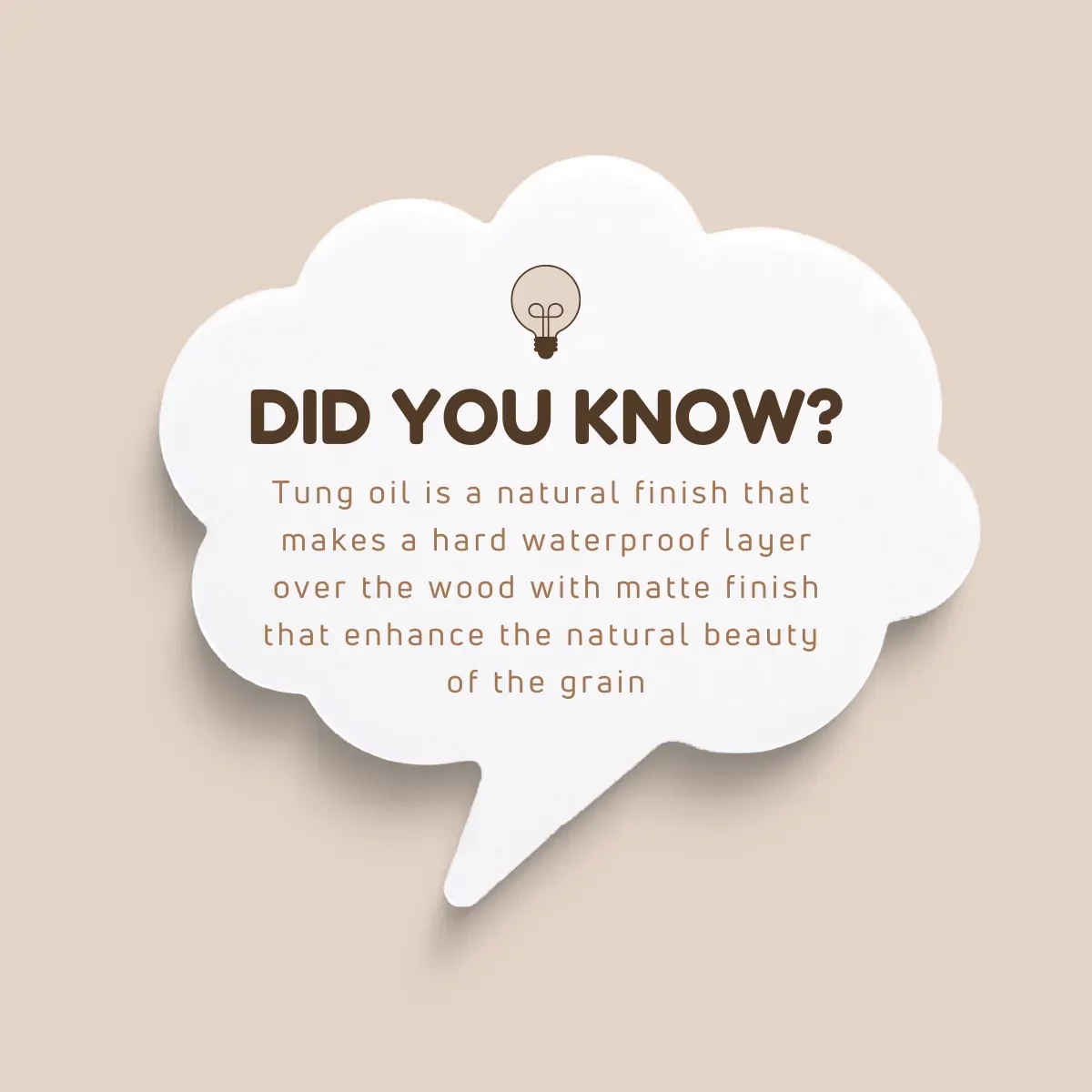
It is a food-safe wood finisher that can use as an alternative to Linseed oil and Danish oil.
See my What Is Tung Oil? for more details about the Tung Oil finish.
Let’s discuss each of the advantages and disadvantages of tung oil in detail.
Plus, I’ll discuss how to minimize its disadvantages to get the best out of it as well. Just keep reading!
Advantages Of Tung oil
1. Tung Oil is Waterproof
Tung oil is waterproof oil and helps to protect furniture and other woodwork from water droplets and moisture.
It works as a water-resistant coating on top of the wooden surface and prevents water molecules and moisture from going inside the wood.
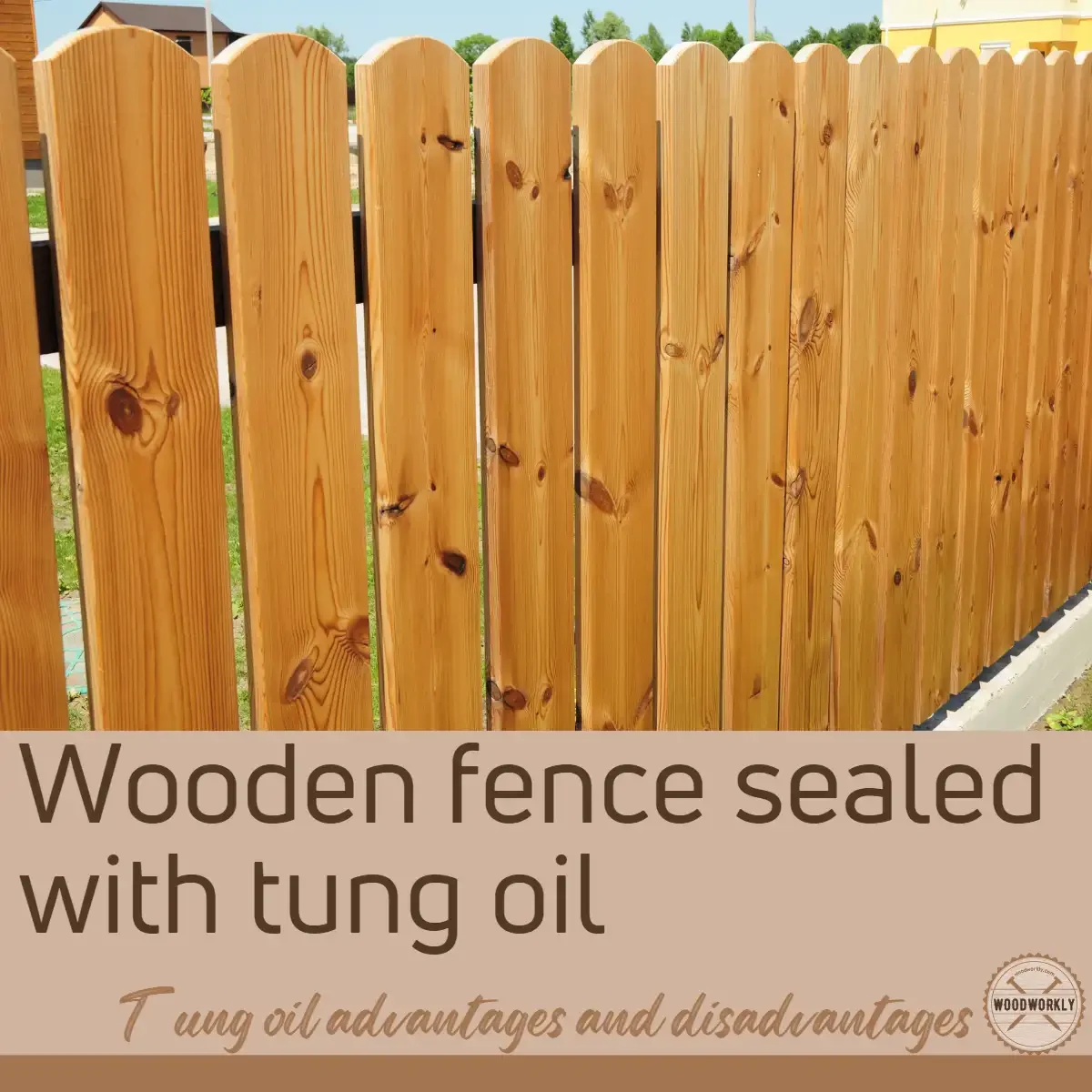
Therefore, even though the wood you have chosen for woodwork has no water resistance, applying Tung oil, it’ll be safe from absorbing water.
But make sure that the wooden surface is cured and Tung oil is applied properly without missing any spot.
As a finishing oil, Tung oil hardens to a tough coat as long as it’s exposed to air.
The components of Tung oil crosslink with atmospheric oxygen and polymerize to make a hard, water-resistant film.
In this process, Tung oil absorbs 12% of atmospheric oxygen to form waterproof skin on wooden surfaces.
This is the chemical reaction process behind the waterproofing ability of Tung oil.
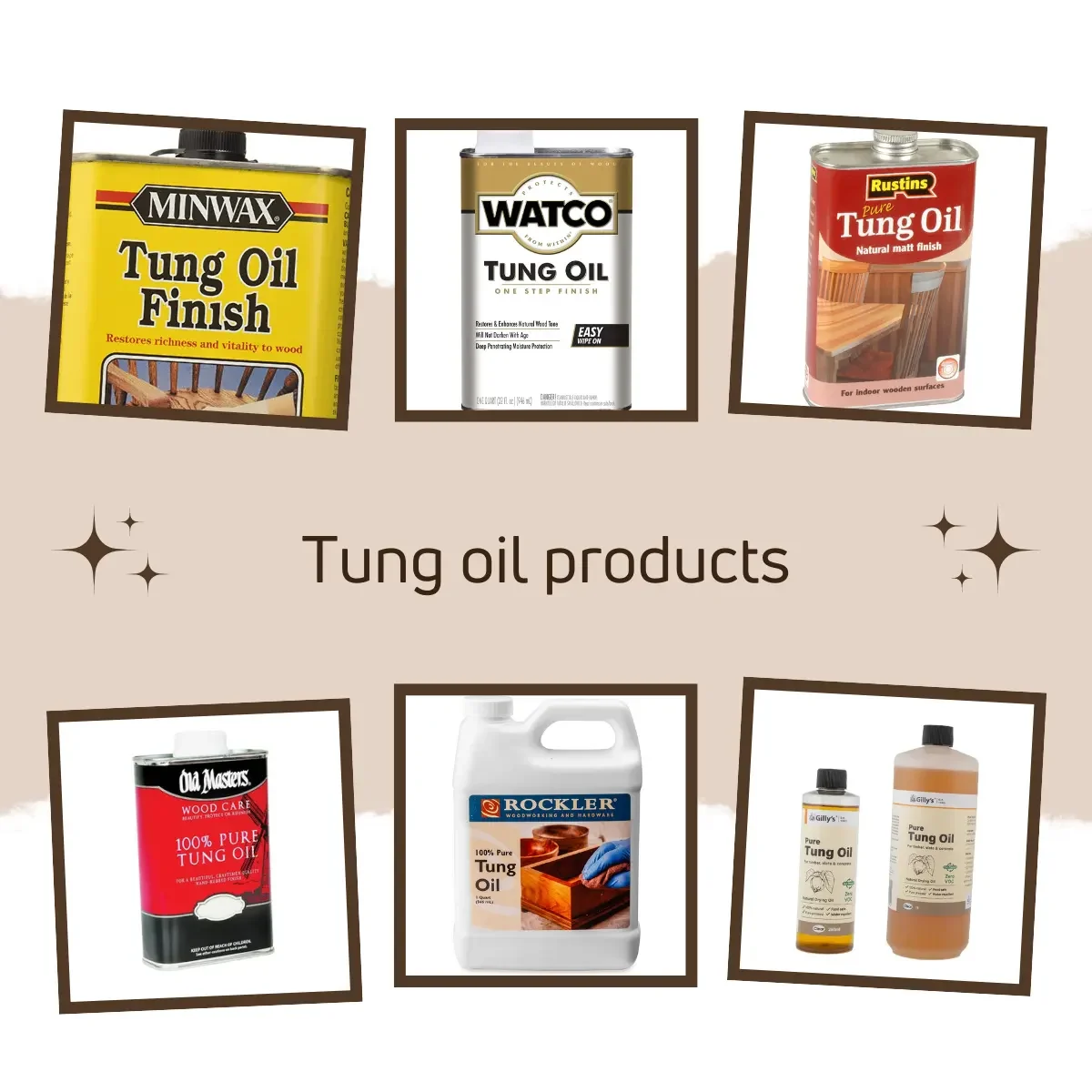
2. Tung Oil Is Non-Toxic
Tung oil is completely non-toxic. It doesn’t contain VOCs. Being natural is the best factor to consider Tung oil as a non-toxic finisher.
Because it’s completely made of crushing seeds of tung trees without adding any artificial ingredients.
It can use to make kitchen utensils and children’s toys. 100% pure Tung oil is safe on toys and make sure to cure the toy for around 30 days before use after application of Tung oil to gain the best results.
Tung oil is resistant to pests and insects.
Therefore, it can apply to any woodworking project and cause no harmful effects on our health and safety.
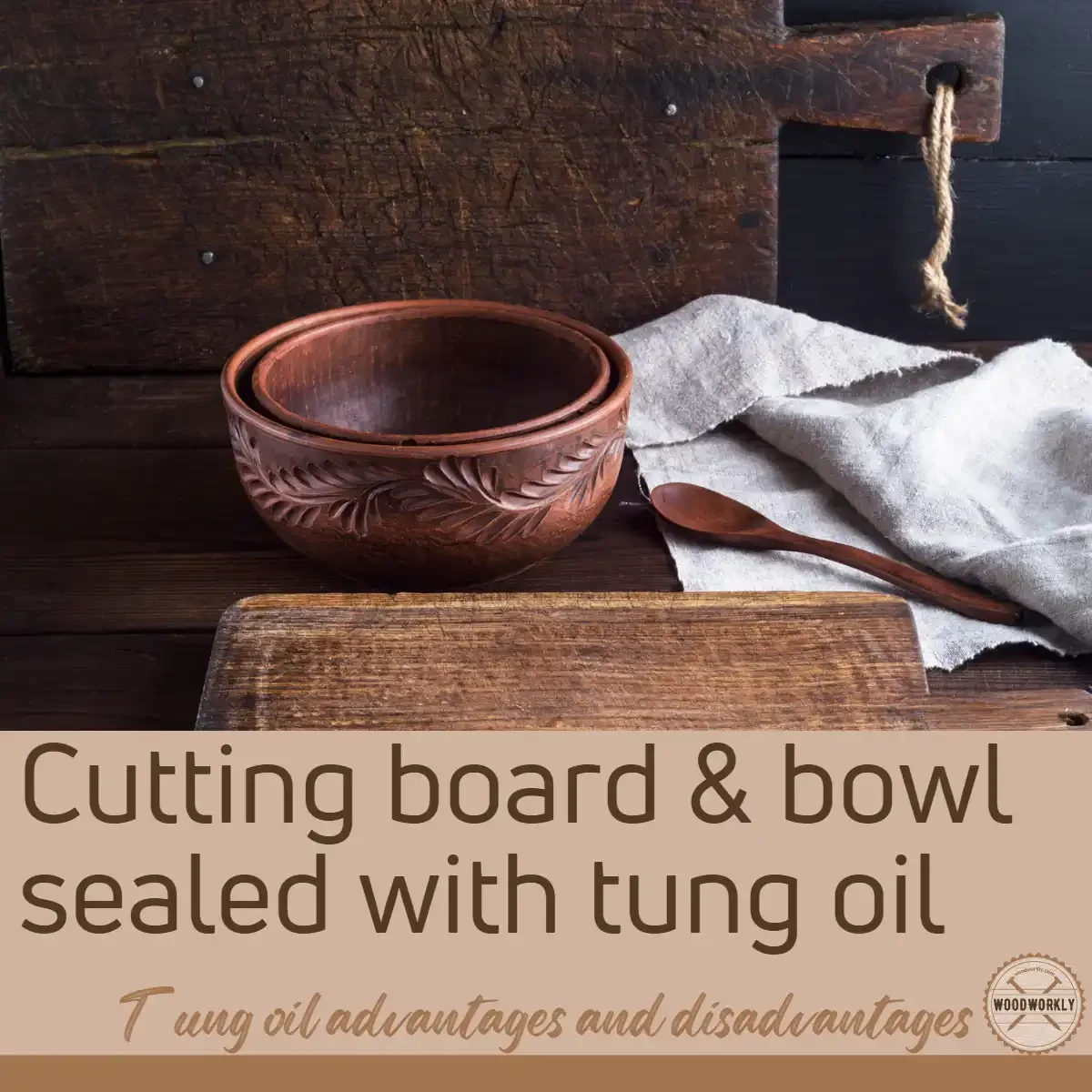
But when Tung oil is exposed to air, oxidation happens and produces hydrocarbons and aldehydes in very little concentration.
These amounts are not harmful to most people and animals.
3. Food Safe
Tung oil is 100% food safe. It is extracted from tung nuts. You can apply it on any kitchen utensils such as cutting boards, butcher blocks, countertops, bowls, baskets, and many more.
Once the Tung oil is applied make sure to keep it for around 30 days until it is fully cured.
Otherwise, the chemical ingredients of tun oil can release from its surface and cause lots of trouble.

If you’re using open-grained pores wood as a cutting board, you’ve probably noticed the moisture will not be inside the wood.
Those woods are excellent for the growth of bacteria and can cause food allergies for a long time usage.
But applying Tung oil which works as a grain filler and prevents water from getting inside the wood and stops bacteria and fungi growth. This is how to make wood food safe.
Pure Tung oil doesn’t contain volatile compounds which are hazardous to meat and vegetables.
Tung oil is the best natural finishing oil which gives the maximum protection for foods and your health.
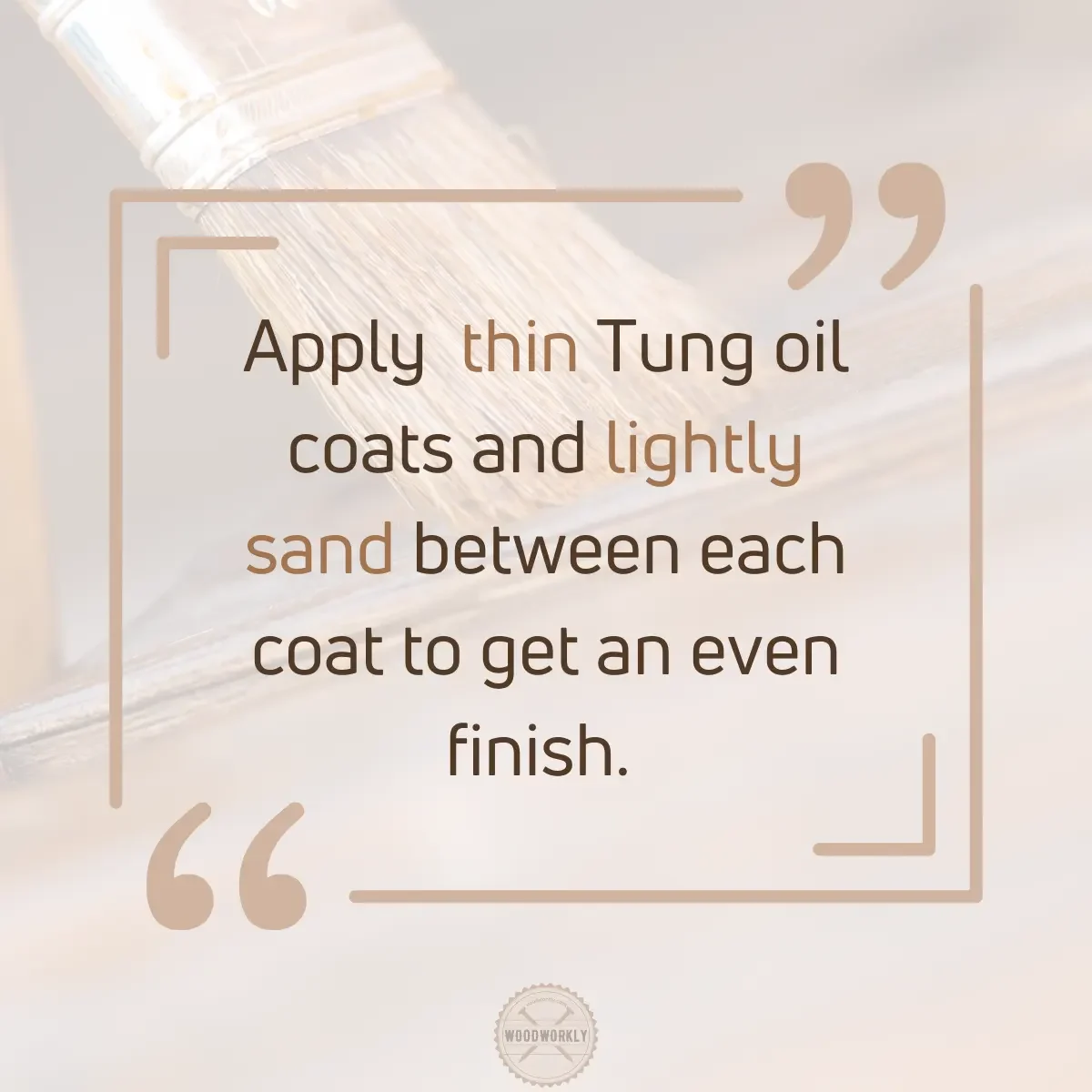
4. Tung Oil Is Easy to Apply
Applying Tung oil is so much easy. It produces an easily maintained and durable finish easily and effectively.
Apply Tung oil using a paintbrush or cloth along the direction of the wood grain for better results. This will help the wood to absorb the oil so much easier.
Even a beginner in woodworking can apply Tung oil without any issues.
Apply a minimum of 6 coats of Tung oil for better results.
Make sure to let the wood dry after the application of each coating of Tung oil for more than 6 hours.
Once you feel the surface is smooth and dried, go for the next coat of stain and repeat the drying process.

Let’s find out the procedure of applying Tung oil effectively and easily without causing any trouble.
How To Use Tung Oil?
- Sand the entire wooden surface with 220 grit sandpaper with even pressure until you get a nice and smooth surface.
- Clean the sawdust and debris using a damp cloth
- Apply the first coat of Tung oil along the direction of the wood grain using a paintbrush without missing any spots.
- Leave the wood for more than 6 hours to dry completely.
- Once the wood is completely dried, apply the second coat of Tung oil after rubbing the surface slightly using 660 grit sandpaper after dipping it in Tung oil for better absorbance.
- Let the wood dry for several hours and apply another coat of Tung oil once it is fully dried and absorbed to the surface.
- Repeat the above procedure for a minimum of 6 coats of Tung oil to get the best results with excellent protection.
Tips:
- Let each tung oil coat dry properly between coats.
- Apply thin tung oil coats to easily get an even finish with no blotches.
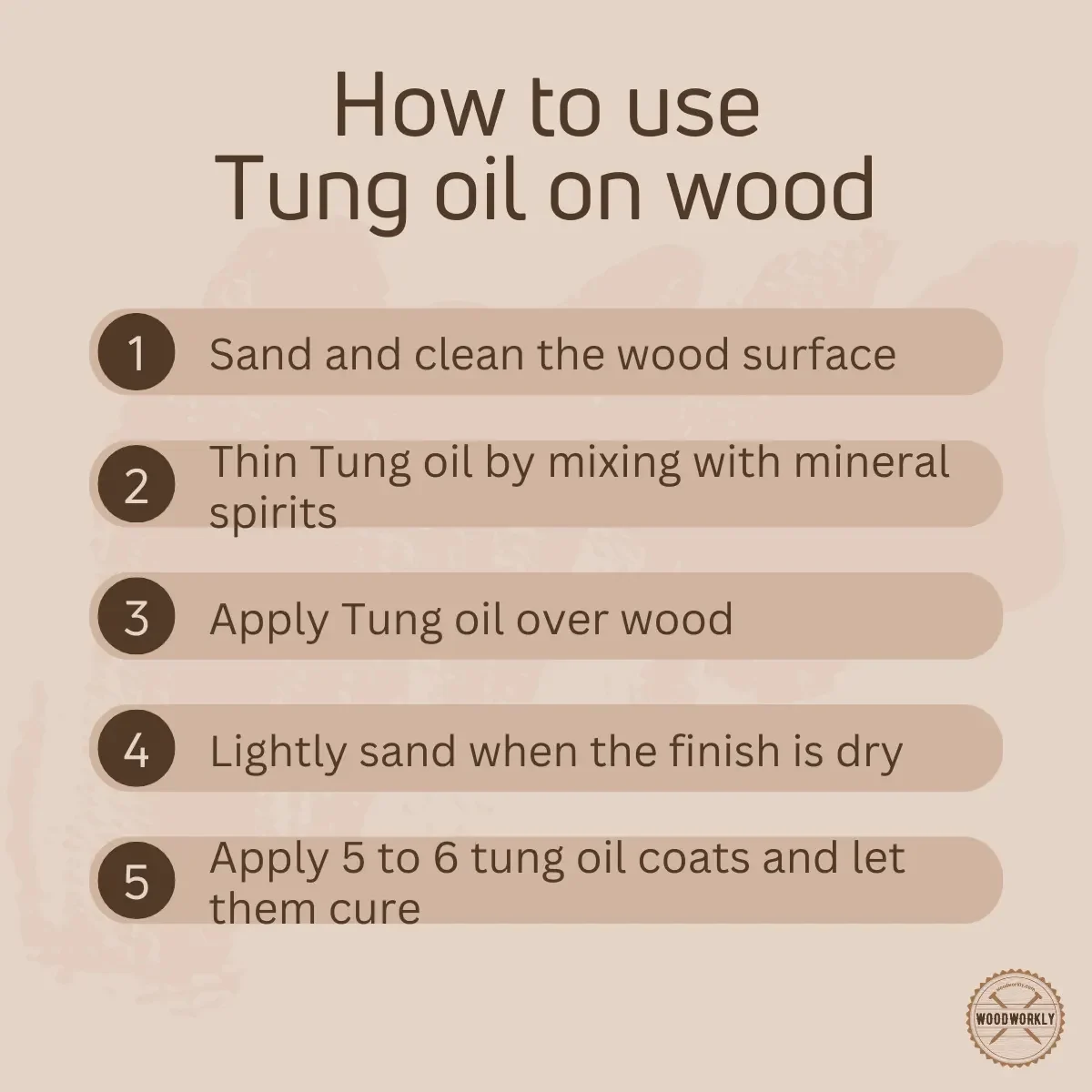
5. Attractive in Color
Tung oil has natural transparent color. You can achieve a pretty impressive color with sheen by applying Tung oil patiently.
But it takes time to penetrate the oil and changes the appearance of the wood.
Once tung oil is applied to the wooden surface, it gives deep golden-rich color with a wet floss look to the surface.
Tung oil not only works as a protective film but also improves the appearance of the furniture.
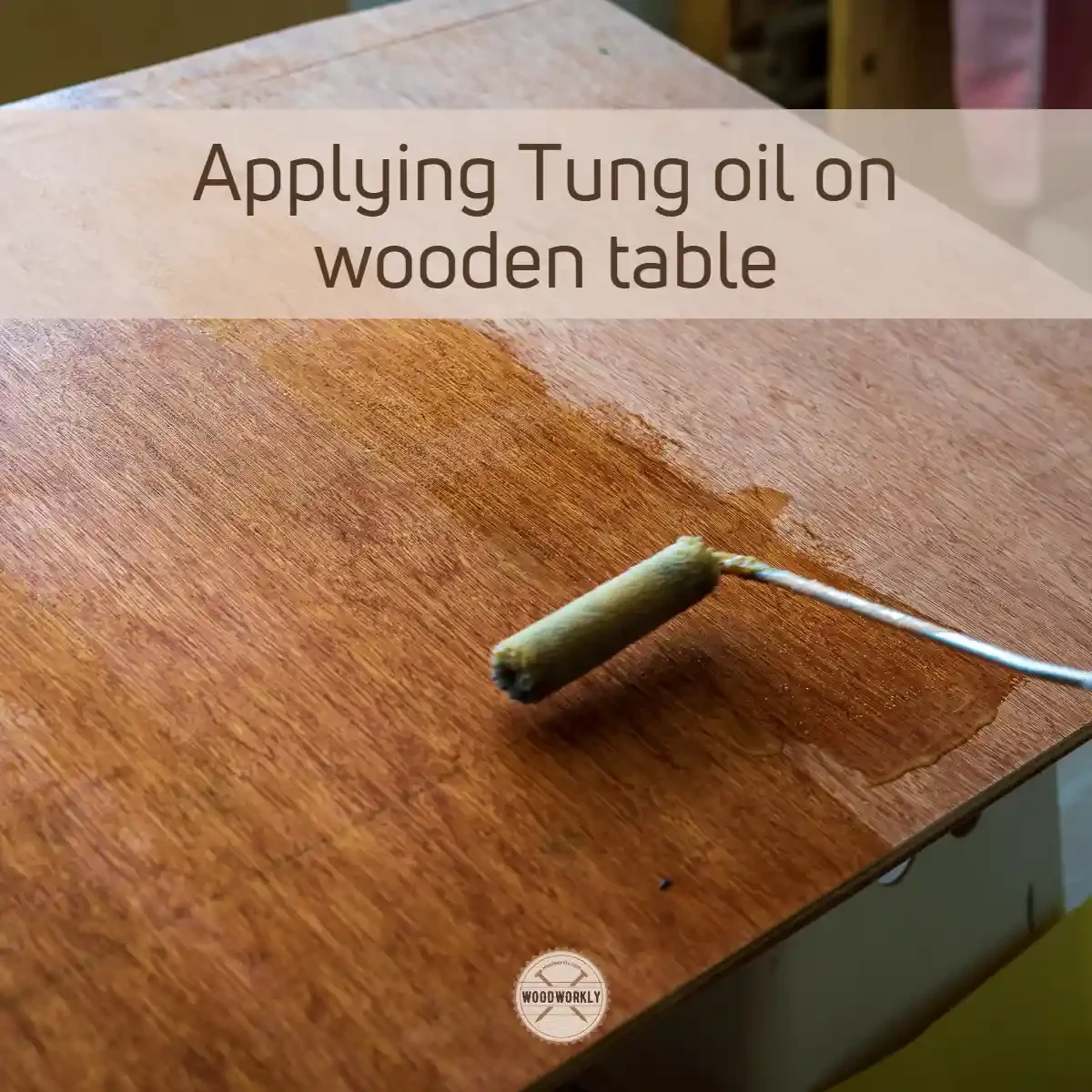
You can get nice looking glossy finish using by applying around 8 coats of Tung oil. The extra sheen increases the beauty and the appearance of the woodwork.
The advantage of using Tung oil is that it doesn’t give glossiness which looks similar to a plastic shine. It just helps the wood to improve its natural shine.
Tung oil gives the wood a darker look with warm rich color which gives a pleasing feeling.
You can get a nice, even-looking surface by lightly sanding the tung oil coat with 600-grit sandpaper along the wood grain.
6. Doesn’t Yellow Over Time
The Tung oil finish doesn’t turn yellow color or rancid over time like most of the finishes do.
Therefore, you’ll be able to keep the color of your loved furniture more stable for a long time with no discoloration or fading.
It’ll be fresh as new with Tung oil.
This is where tun oil is different from other finishing oils like Linseed oil, varnish, and polyurethane finish. Because those are prone to discoloration.
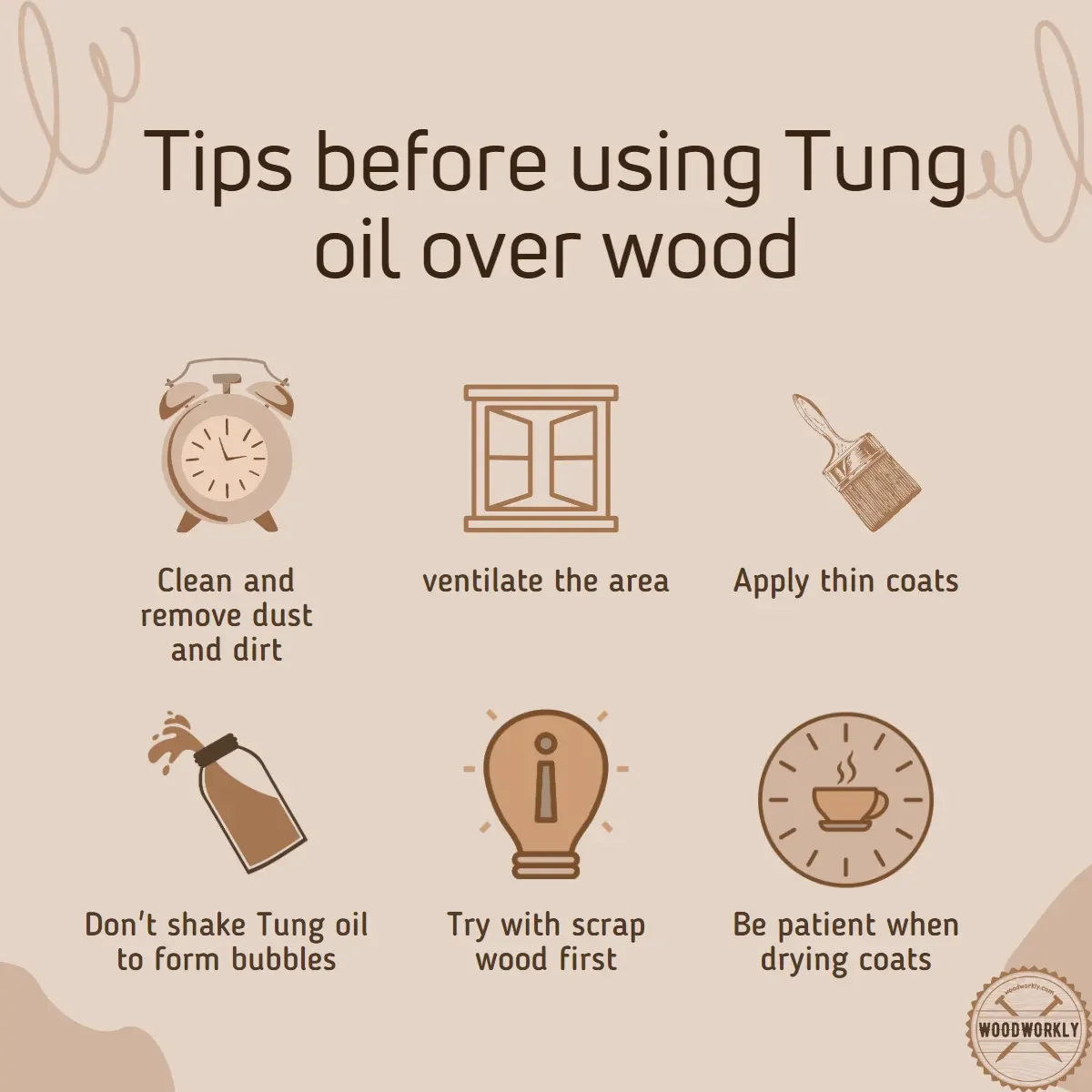
You should do the maintenance once or twice a year by applying linseed oil from the beginning.
But with Tung oil, you don’t have to worry about that, because it doesn’t change the color under any circumstances.
7. Resistant to Acids and Alcohols
Tung oil is not only waterproof but also resistant to various acids and alcohol.
This is why Tung oil is popular for applying for cutting boards, and desk countertops.
Tung oil is resistant to,
- Dust
- Alcohol
- Acetone (nail remover)
- Vegetable acids
- Fruit acids
For example, if you have spit orange juice on countertops finished with Tung oil, you can easily clean it up using cloth because fruit acid cannot destroy the Tung oil film.
Tung oil doesn’t let acids penetrate inside the wood.
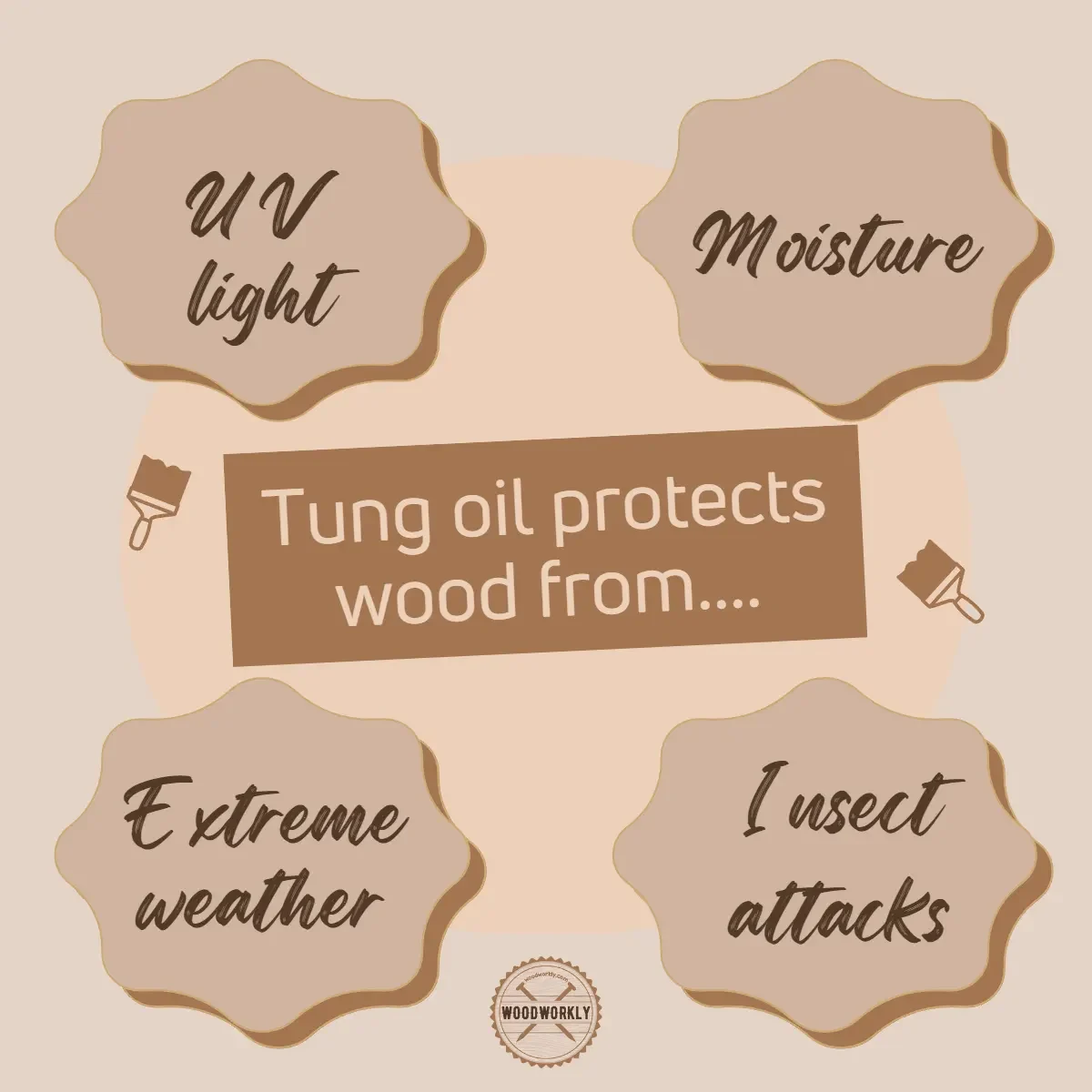
As you can see Tung oil is an excellent oil finisher that can use for any interior woodwork to give protection from environmental elements and to improve the appearance to look fresh as new.
8. Elasticity
Even though Tung oil hardens pretty well, it has a tremendous amount of flexibility and elasticity.
Therefore, even in harsh weather conditions, the Tung oil layer won’t crack easily and increase the lifespan of the wood.
Because of the elasticity property of Tung oil, when the wood expands and contracts due to humidity changes in the outside environment, the Tung oil coating will also expand and contract along with the wood without losing its stability.
This is so much important as a finisher which makes Tung oil versatile.

The elasticity of Tung oil doesn’t go even when it is fully cured and turned into a solid polymerized structure. The compatibility of Tung oil with the wooden surface is exceptional.
There will be no cracking, scratches, or dull spots that will remain on the wood due to expansion or contractions of Tung oil coating.
As we have discussed the most important advantages of Tung oil areas above.
So, let’s turn the table and head into the disadvantages of Tung oil.
I’m pretty sure, the disadvantages of Tung oil will be important as the advantages to avoiding mistakes and making the finishing look perfect as you’re looking for.
So, let’s jump in!
Disadvantages Of Tung oil
1. Slow Penetration
Tung oil penetration to the wood is super slow. Therefore you’ll need a lot of time to apply tung oil over wood surfaces.
Unlike many other oil finishes, Tung oil needs at least 6 or more coats to complete the penetration to the wood and make a perfect Tung oil layer surface.
This is so time-consuming and you need to put lots of effort to finish that many coatings.
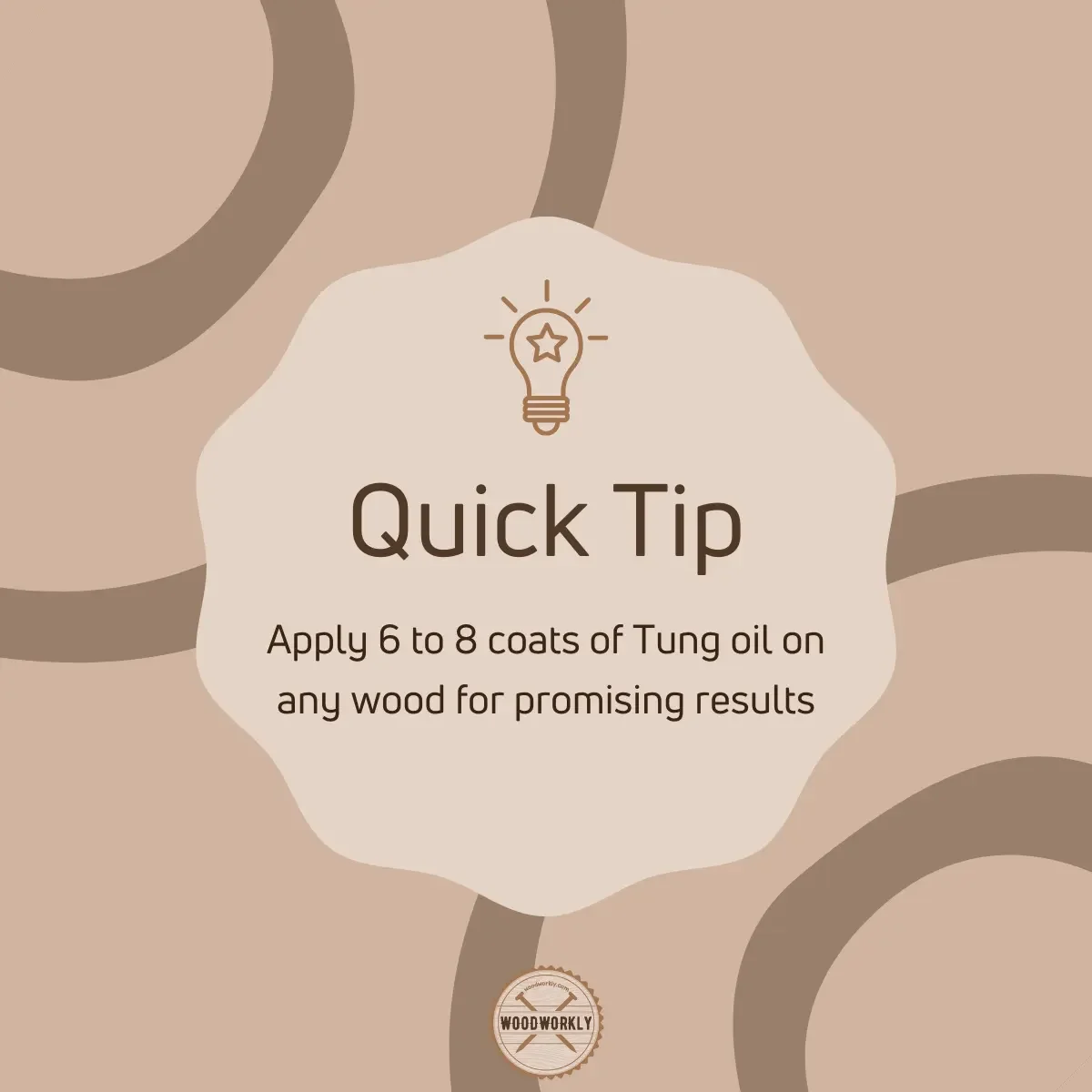
The drying time for each coat is around 3 to 4 days due to the slow penetration of Tung oil.
In order to increase the penetration speed of tung oil to the wood, sand the entire wood surface before applying tung oil.
Sanding helps the wood to adsorb tung oil better since it opens the pores of the wood.
Plus, sanding between each coat of Tung oil is recommended for effective and even Tung oil finishing.
2. Unpleasant Odor
Tung oil produces a mildly unpleasant, distinct odor for a few days until it is fully cured after it is applied.
Better to wear a mask when applying Tung oil because its harsh, chemical odor can cause respiratory problems.
However, the odor will go away over time when the coating is eventually drying.
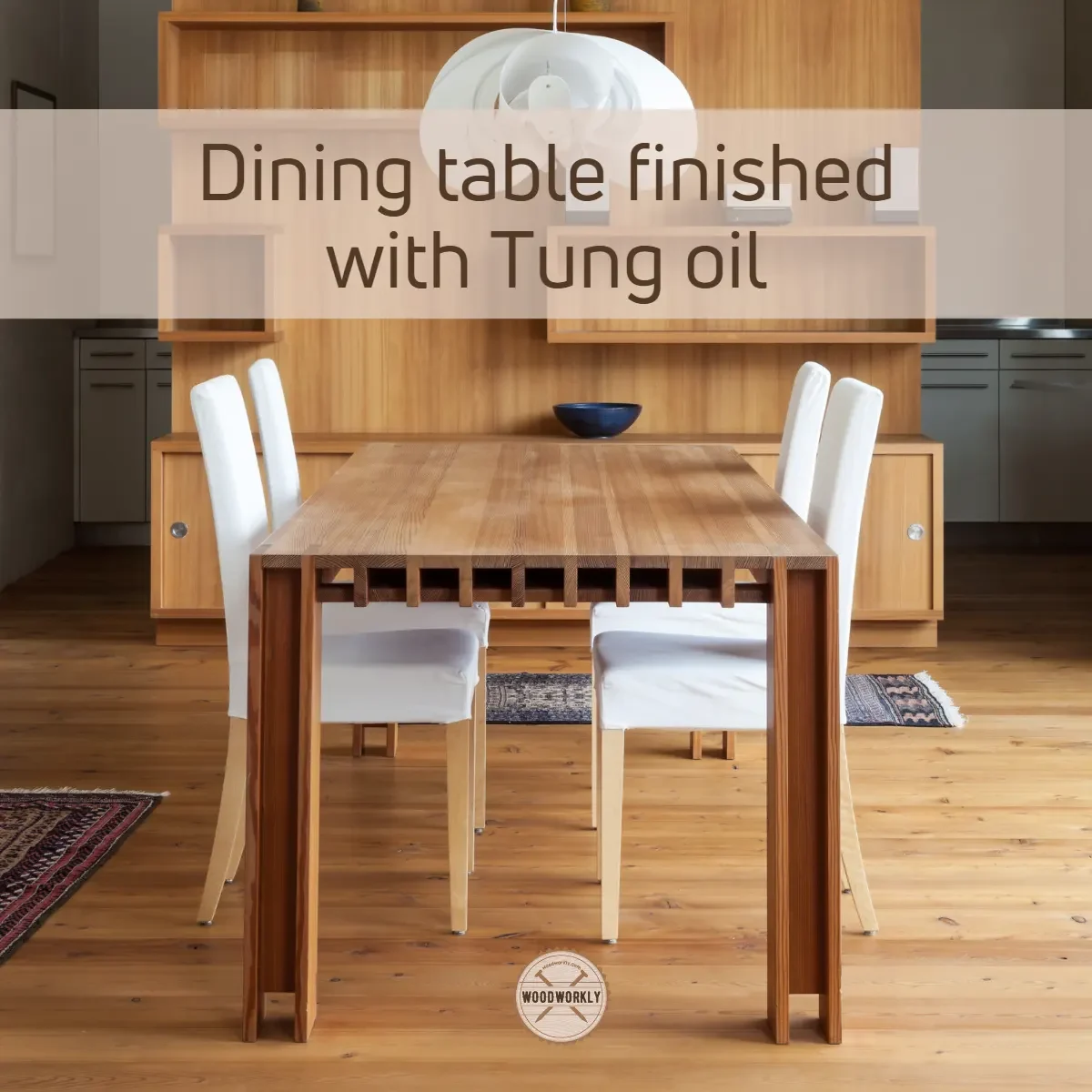
If you don’t like the smell of Tung oil, better to dilute and thin it with mineral spirit.
Because mineral spirit has the ability to mask the distinct odor of Tung oil. But according to my experience, I’ve never found Tung oil’s odor offensive to me.
But lately, there are a lot of Tung oil commercial products that are free of the smell of natural Tung oil.
You can easily prevent this disadvantage of Tung oil by using mineral spirit or by using an alternative commercial product.
3. Long Processing Time
Not like many other finishing oils, Tung oil takes around 30 days to fully cure. Never place Tung oiled woodwork or furniture in direct sunlight until it’s fully cured.
During the first 10 days, check the wooden surface frequently and wipe off the Tung oil that seeps into the surface.
The long processing time of Tung oil to settle in the wood is one of the main drawbacks that cannot be skipped.
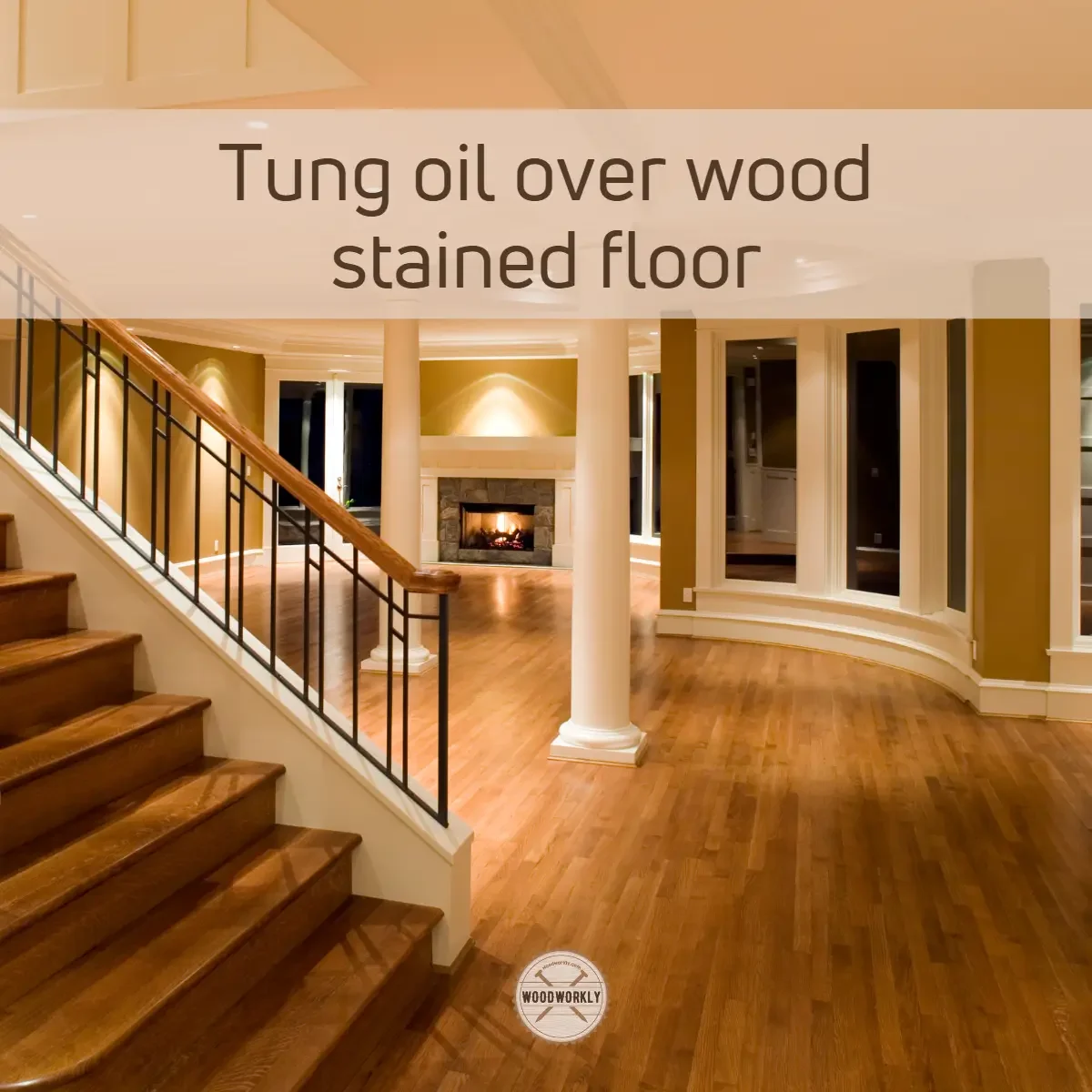
During the curing time make sure not to place heavy objects on top of the wood and protect the wood from mud and dirt because the surface is tacky, and it’ll be so hard to remove them once they’re attached.
You’ll have to wait until the wood is naturally waterproof, seals the wood, and protect the surface.
4. Expensive
Tung oil is relatively more expensive than other similar finishing oils such as Linseed oil.
You can save money by buying a larger amount of Tung oil if you’re using it for large woodworking projects.
Generally, Tung oil is nearly 25% more expensive than other popular oil finishes such as,
- Linseed oil
- Varnish
- Polyurethane
- Some paints
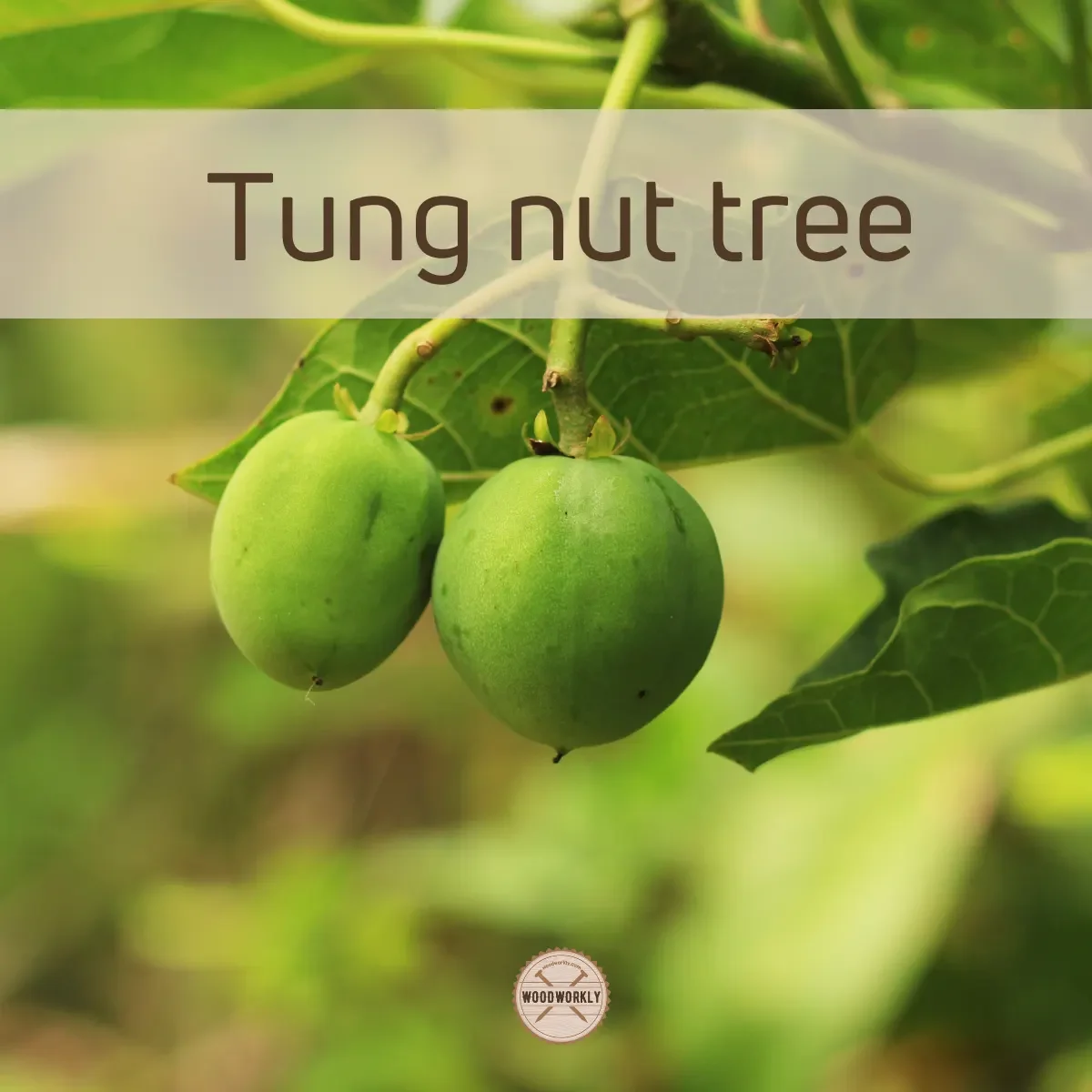
5. Difficult to Store
Never keep the Tung oil can in direct sunlight. Tung oil reacts with heat and light and that causes it to ruin the product.
Therefore, storing Tung oil is difficult, and always select a dark, area under room temperature to store Tung oil. Keep it away from a lot of light and heat.
With exposure to light and heat, the Tung oil container will form a film or gummy-like deposits around the corner of the lid of the can.
Once you notice those, there’s no use of Tung oil, because that means the chemical structure of Tung oil is already changed and it is non-reversible. Therefore, storing location is very important for Tung oil.
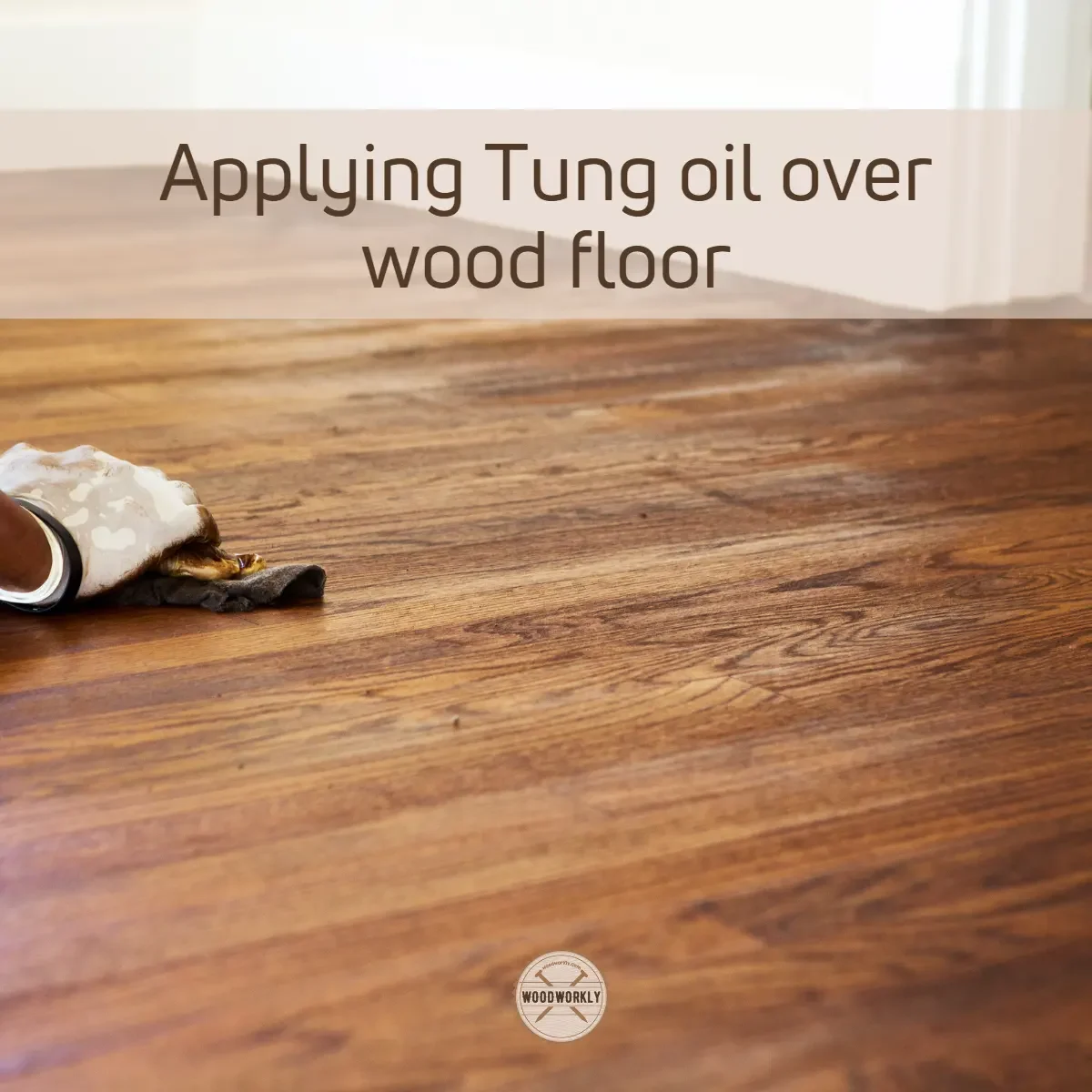
Make sure to store tung oil in a dry place with no chemicals to avoid Tung Oil from going bad.
6. Doesn’t Smoothen Wood Grain
Tung oil does not have the ability to smoothen the wood grain. Therefore, after each coat of Tung oil, the surface should be wet sanded to get a smooth wood grain.
The brush marks also will disappear after the surface is wet sanded properly.
As you can see the disadvantages of Tung oil are good to know before applying Tung oil to particular woodwork.
Because when you’re finishing the wood one mistake can ruin whole the woodwork and it’s better to have a good idea about the disadvantages of Tung oil to minimize the mistakes.
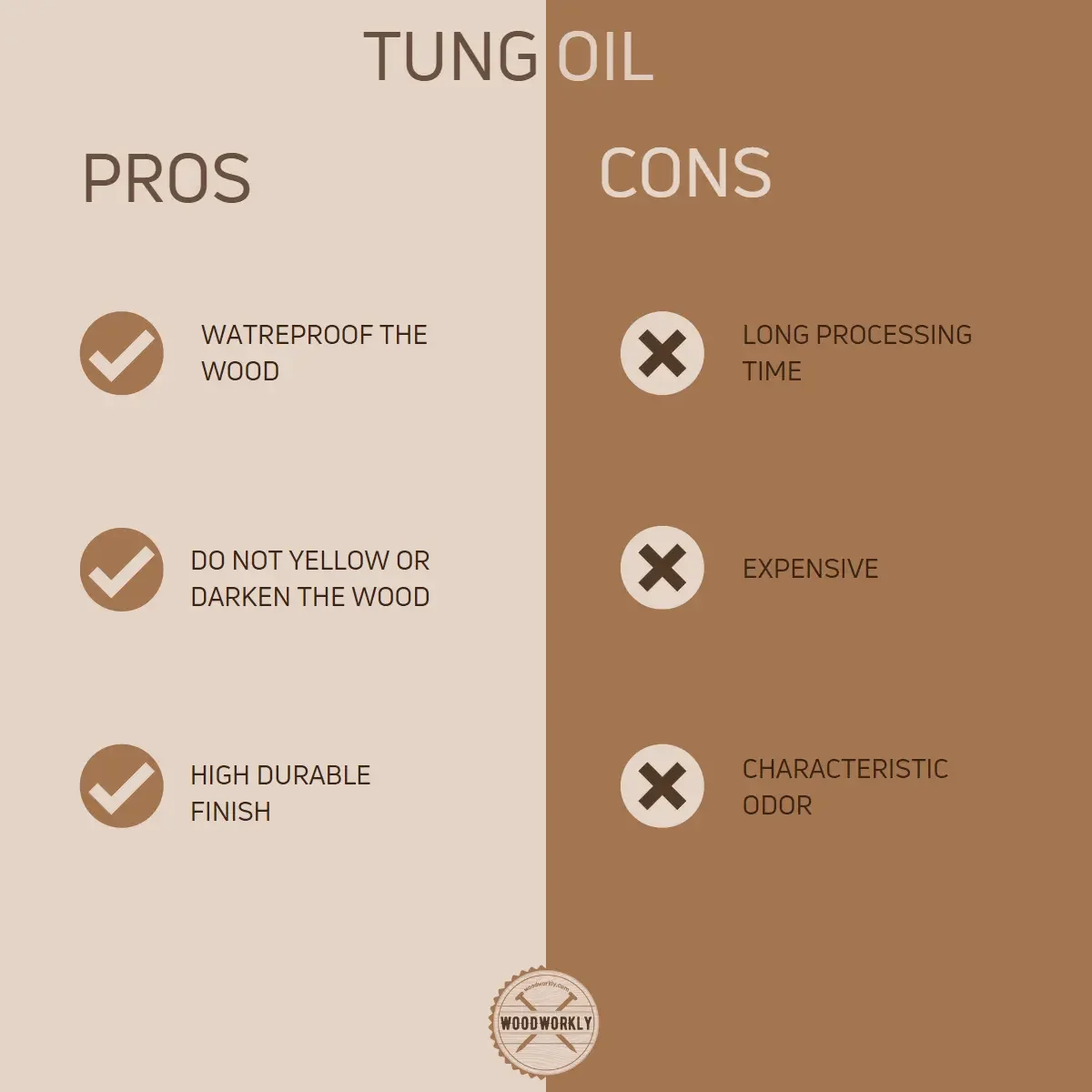
Now you know Tung oil advantages and disadvantages in detail.
So, let’s answer some frequently asked questions about Tung oil.
Does Tung Oil Waterproof Wood?
Yes, Tung oil waterproof wood since it makes a protective coat over wood that prevent moisture and water from penetrating the wood.
It tolerates wood from extreme weather conditions like rain, snow and humidity changes.
Tung oil is cured and hardens to a super tough and tight coat upon reacting with atmospheric oxygen.
Tung oil prevents moisture from going inside the wood and prevents water damage and other environmental impacts.
What Is Tung oil Use For?
Tung oil is a popular wood finisher that can apply basically to any woodworking project. Here’s what tung oil best for,
- Cutting boards
- Countertops
- Butcher blocks
- Kitchen utensils
- Children’s toys
- Interior furniture
Tung oil is applicable for any wood type and for any woodworking project.
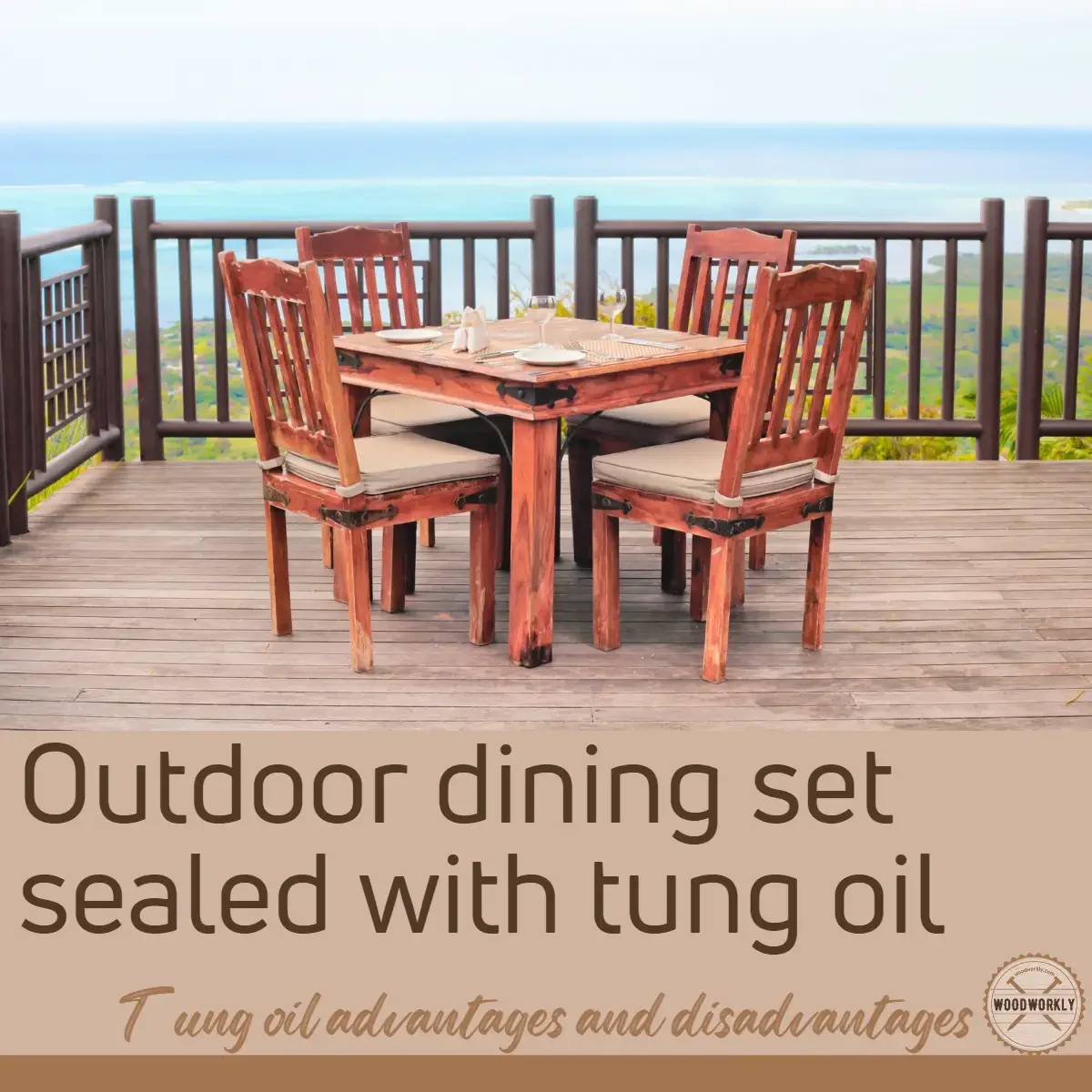
How Many Coats of Tung oil Should I use?
Use 6 to 8 coats of tung oil to protect the wood from weather elements with good water resistance with enhanced wood appearance.
The number of coats of Tung oil you should apply on particular woodwork depends on the,
- Type of the wood
- Glossiness you want
- Level of sheen you want
Generally, a minimum of 6 coats of Tung oil should you used for a better finishing coat.
Tung oil has poor absorbance and slow curing speed. Therefore, you need to apply a lot of coats to get the shade you wish.
For extra glossiness, 8 coats of Tung oil is recommended for better results.
Does Tung Oil Darken Wood?
Tung oil does not darken the wood. It provides a clear finish and will not change color over time.
Tung oil gives a matte clear finish which does not darken or yellow over time.
Apply tung oil at least once per two years to keep the wood and the finish fresh as new for a long time.
Which Is Better Linseed Oil Or Tung Oil?
Tung oil is better than Linseed oil since tung oil makes a more stable, hard, and durable finish than Linseed oil.
Tung oil makes a more waterproof coat over wood and helps to protect better than Linseed oil.
Plus, Linseed oil takes more time to cure compared to tung oil.
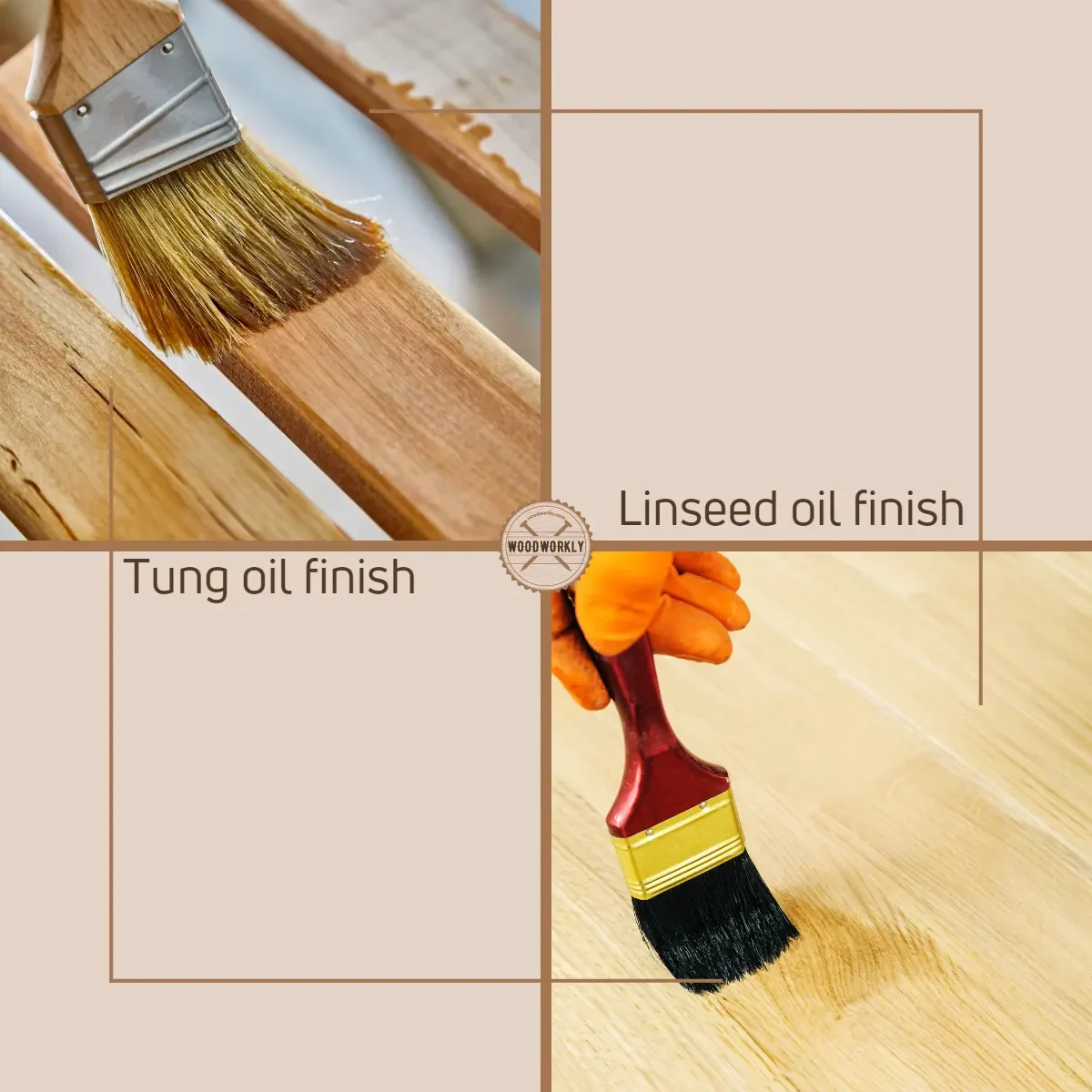
But on the other hand, tung oil is more expensive than linseed oil. But overall tung oil is more versatile than linseed oil.
Here’s an in-depth review of the differences between Tung oil and Linseed oil.
Tung Oil Vs Linseed Oil
| Tung Oil | Linseed Oil |
| Prove a clear finish | Slightly yellows over time |
| Dry and cure within 2 to 3 days | Takes 7 to 14 days to cure |
| High durability | Low durability |
| Expensive | Cheap |
| Matte finish | Satin finish |
| High water resistance | Low water resistance |
| Extract from tung seeds | Extract from flaxseeds |
Is Tung oil the Same as Danish Oil?
Both Tung oil and danish oil belong to the finishing oil category. But they are not the same.
Tung oil is a natural, eco-friendly finishing oil that extracts from tung seeds while Danish oil is an artificial finishing oil.
Tung oil is one of the main ingredients in making Danish oil. Therefore, Danish oil contains some features of Tung oil.
There’re so many pros and cons of Danish oil as well.
Here’re the differences between Tung oil and danish oil in terms of their properties and uses.
| Properties | Danish Oil | Tung oil |
| Appearance | Satin / Semi-gloss | Matte |
| Drying time | 6 hours – 1 day | Around 3 -4 days |
| Number of coats needed | 2 – 3 coats | 6 – 8 coats |
| Uses | Indoor furniture, wood handles, kitchen utensils | Kitchen utensils, boats, countertops |
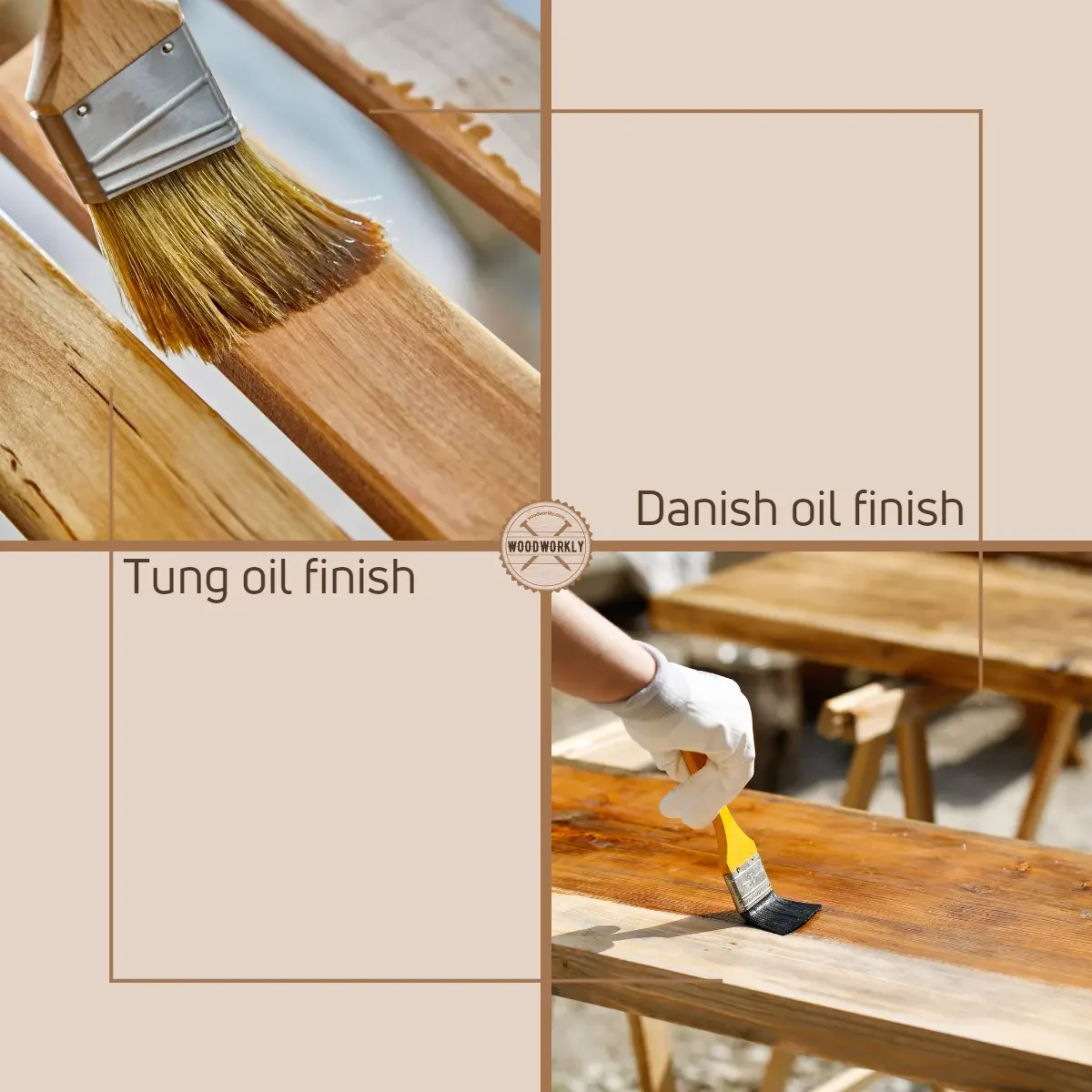
Tung Oil Vs Danish Oil
| Tung Oil | Danish Oil |
| Prove a clear finish | Slightly yellows over time |
| Dry and cure slower within 2 to 3 days | Dries and cures faster within 1 day |
| Relatively less durable | More durable |
| Natural finish | Man-made |
| Matte finish | Glossy finish |
| Relatively less water resistant | High water resistant |
| Relative less stable | High stable |
As you can see, Danish oil is better than Tung oil. Danish oil dries faster and makes a more durable finishing coat than Tung oil. Plus, Danish oil is easier to use.
Is Tung oil Good for Cedar?
Tung oil works perfectly on Cedarwood. Tung oil makes a protective layer over cedar while giving a dark rich look to the Cedar wood furniture and woodwork.
Tung oil sticks well onto the cedar wood surface and protects the wood from weather elements, insect attacks, moisture, and water damage.
Plus, it enhances the cedar wood appearance with a matte finish.
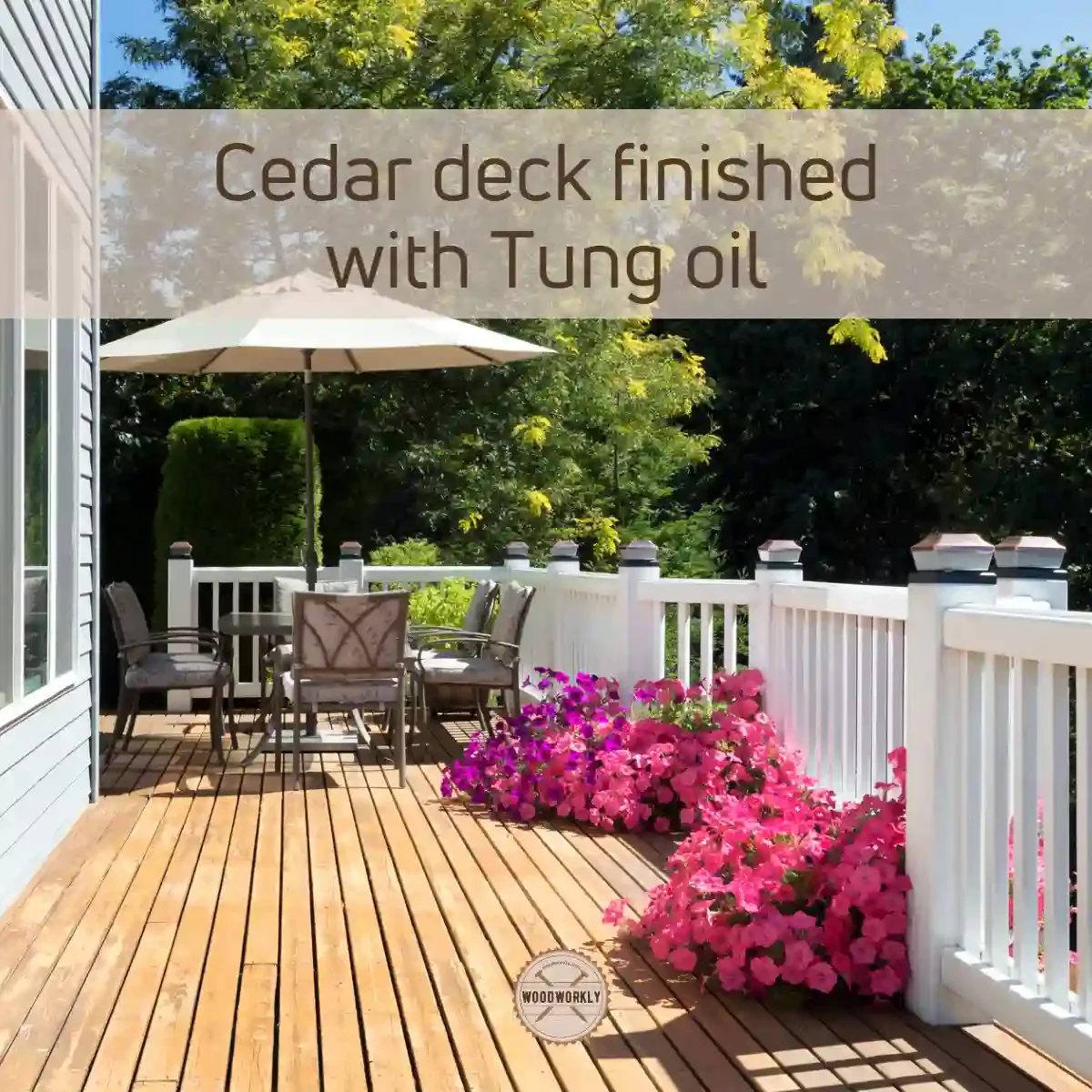
Cedarwood decks, panels, frames, fences, sidings, and musical instruments absorb Tung oil and help build a nice uniform protective film over the wooden surface.
When you’re applying Tung oil on Cedarwood, make sure to apply along the direction of the wood grain to get the best results.
Can You Use Tung Oil On Oak?
Yes, you can use tung oil on oak with no issues. Tung oil makes a protective layer over oak while giving a dark rich look to the Cedar wood furniture and woodwork.
Tung oil sticks well onto both Red Oak and White Oak surface and protects the wood from weather elements, insect attacks, moisture, and water damage.
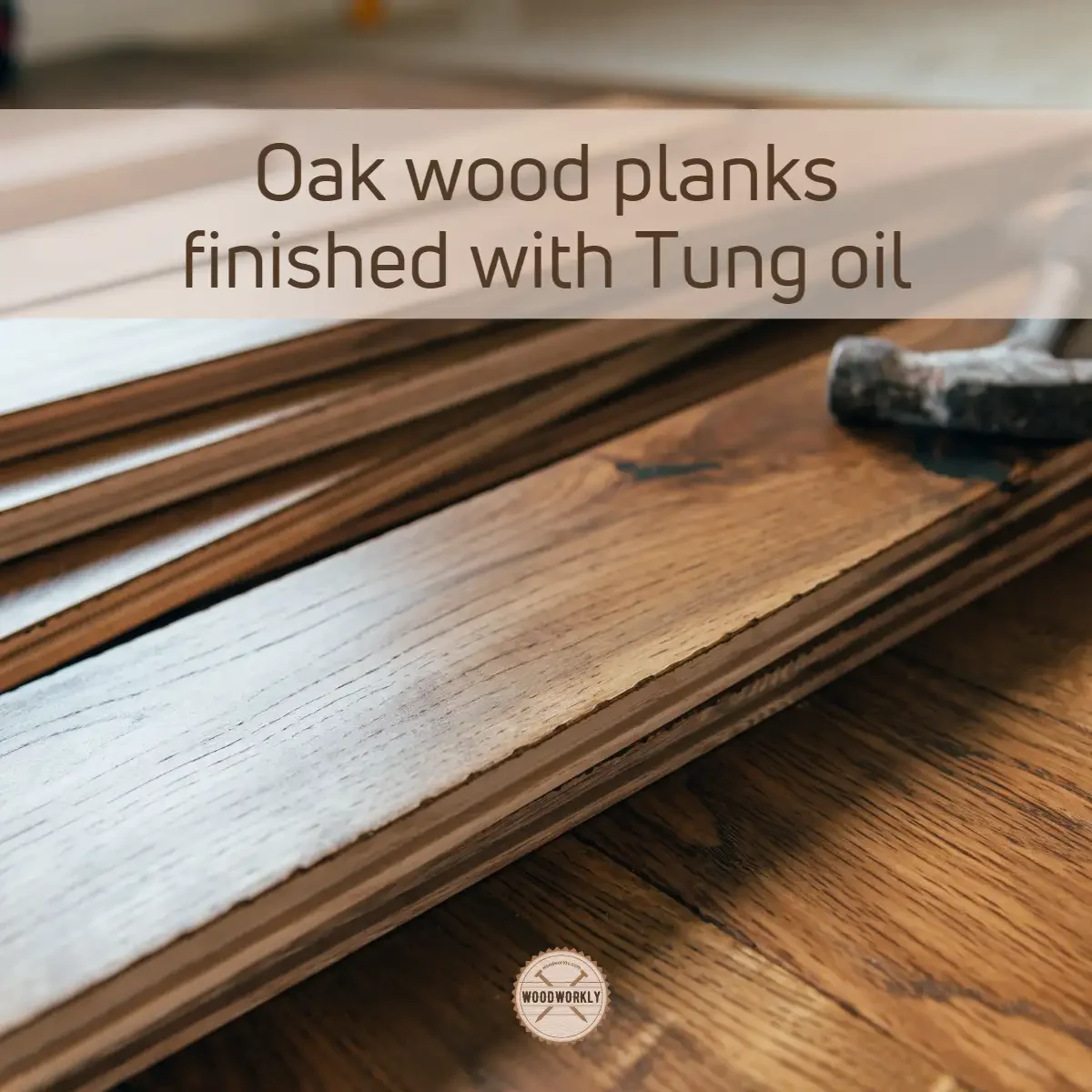
Can You Use Tung Oil On Walnut?
Yes, you can use tung oil on walnut with no issues. Tung oil makes a protective coat over walnut while giving a dark rich look to walnut wood furniture and woodwork.
Tung oil sticks well onto the walnut wood surface and protects the wood from weather elements, insect attacks, moisture, and water damage.
Apply thin tung oil coats over walnut for promising results.
Is Tung Oil Good For Exterior Use?
Yes, tung oil is good for exterior use since it is water resistant and tolerates extreme weather conditions such as rain, snow, and temperature changes.
Plus, tung oil can resist insect and bug attacks. It protects wood from cracks and dents.
Therefore, you can use tung oil for exterior furniture and woodwork. With proper maintenance, you can have exterior furniture for years with tung oil.
Can I Use Tung oil Over Stain?
Yes, you can use Tung oil over stained wood surfaces. But you need to make sure the stain is oil-based.
Because Tung oil is well compatible only with oil-based stains. Tung oil doesn’t combine well with water-based stains.
But you can use tung oil over a water-based stain by lightly sanding the water-based stain coat before tung oil to build good adhesion between surfaces.
Sanding helps tung oil to stick well on to even over the water-based stain with no layer separation.
While the stain is giving a nice appearance to the furniture, Tung oil can use to give extra protection from outside elements like moisture, insect attacks, and many more.
Can I Paint Over Tung oil?
Yes, you can paint over the Tung oil surface. Tung oil sticks well onto the paint once it is fully dried and cured.
First of all, clean the surface using soap and water. Then do a light sanding and apply a prime coat to seal the surface perfectly.
Light sanding paint layer helps to build good adhesion between tung oil and paint.
Then you can apply paint over Tung oil without any issue.
Tung oil is an oil-based finisher; therefore, I highly recommend using oil-based paint over Tung oil for better compatibility.
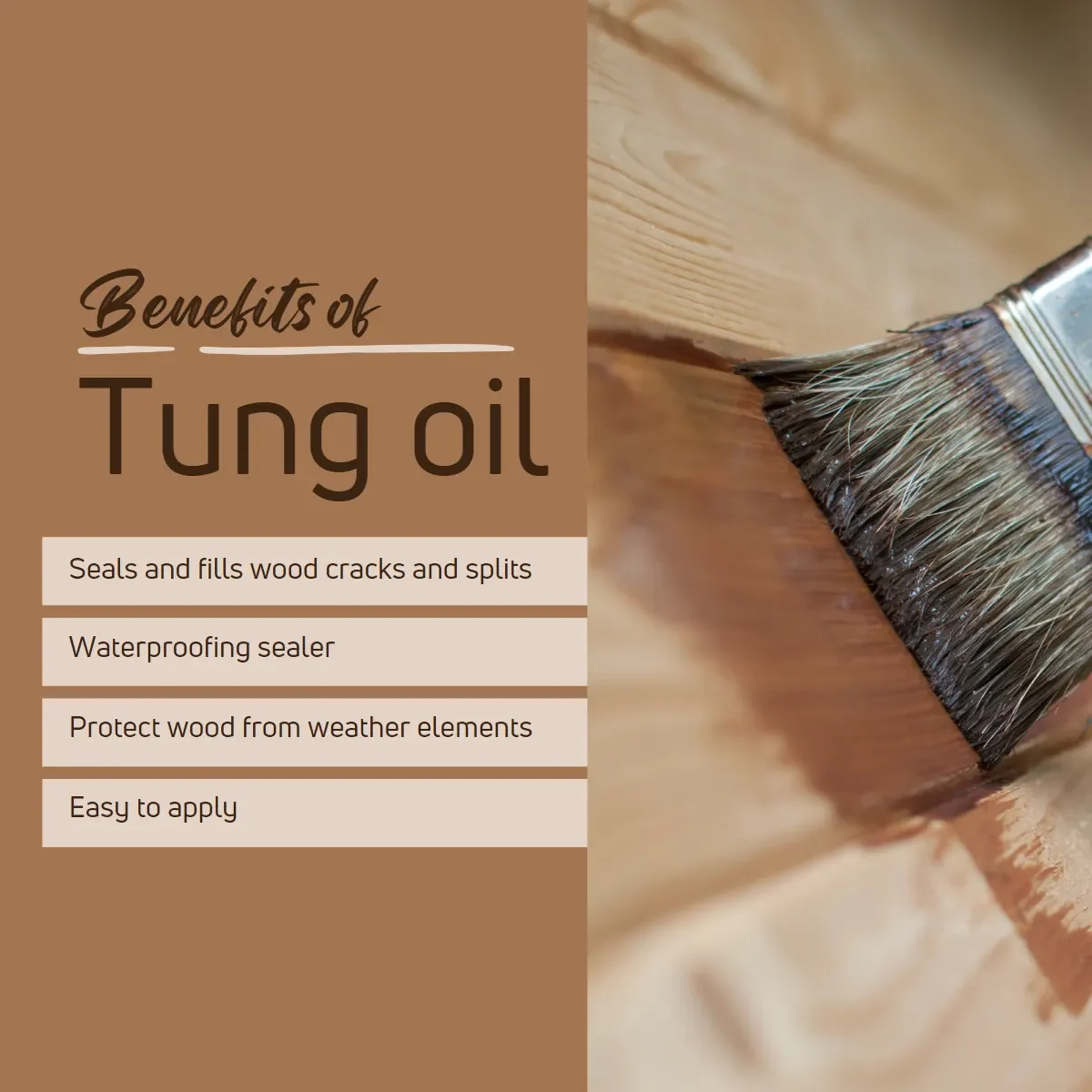
Can I Stain Over Tung oil?
Tung oil is designed to harden the surface and to give protection for the wooden surface.
The top layer of Tung oil isn’t compatible with wood stain. Therefore, the wood stain will not penetrate through Tung oil.
There is no use of staining wood after Tung oil is applied. Because the protective layer should always expose to the outside.
By applying stain over Tung oil, the protective layer will be covered and there’ll be no use of having Tung oil anymore.
Did I cover all you wanted to know about: Tung oil Advantages and Disadvantages
In this article, I have deeply discussed Tung oil advantages and disadvantages that I have learned over years of working with Tung oil for furniture and different woodworks.
The advantages and disadvantages of Tung oil are discussed separately in detail with the characteristic feature of Tung oil as a finisher.
Overall, Tung oil is an exceptional wood with lots of advantages and you can learn lots of new things through its disadvantages as well.
Waterproof, non-toxic, food safe, high elasticity, and ease of application are the advantages of tung oil while expansiveness, slow penetration, harsh odor, and long processing time are the drawbacks of tung oil.
Furthermore, I have answered frequently asked questions about Tung oil with its uses over wood types like Cedar.
Hope you have gained pretty good knowledge about Tung oil advantages and disadvantages with its qualities.
Try to apply Tung oil as a wood finisher for your next project, to see how the oil works in the practical world.
Have fun in woodworking!